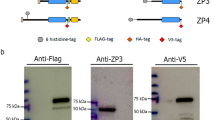Abstract
Fertilization is a process that involves the recognition and adhesion of negatively charged spermatozoa to the oocyte investments. It is not known, however, if charge properties of the interacting gametes play a role in fertilization. The present study evaluates the content and distribution of anionic constituents in the oocyte-cumulus complex of rats. Polycationic colloidal gold (PCG), ruthenium red (RR) and wheat germ agglutinin (WGA) were used as cytochemical markers of anionic sites at the light (LM) and electron microscopical (EM) levels. Isolated oocyte-cumulus complexes were fixed with glutaraldehyde (GA) and OsO4 containing RR, or with GA without RR, and embedded in araldite or LR-gold. For LM, deresined, semi-thin, araldite-embedded sections were labelled with PCG intensified by silver, or with biotinylated lectins visualized by avidinperoxidase. For EM, thin LR-gold sections were labelled with PCG, whereas RR labelling was examined in araldite sections. The zona pellucida (ZP) failed to bind any of the polycationic markers used, but intensely bound neutralized WGA. In contrast, cumulus cell membranes bound PCG but not RR, whereas the oolemma bound RR but not PCG. The results indicate that the ZP is practically devoid of negatively charged constituents, and tends to repel positively charged ligands possibly due to the presence of cationic determinants. The binding of PCG to cumulus cells probably reflects a high content of membrane-bound heparan sulphate, whereas the binding of RR to the oolema indicates the presence of membrane sialoglycoconjugates. We suggest that during sperm-egg interaction the negatively charged spermatozoon may be electrostatically repelled by the cumulus cells, yet at the same time attracted by the ZP.
Similar content being viewed by others
References
Balz JM, Cardullo RA (1989) On the number and rate of formation of sperm-zona bonds in the mouse. Gamete Res 24:1–8
Braden AW (1952) Properties of the membranes of the rat and rabbit eggs. Austr J Sci Res B5:460–461
Cook GMW, Stoddart RW (1973) Surface carbohydrates of the eukaryotic cell. Academic Press, London New York
Dandekar P, Talbot P (1992) Perivitelline space of mammalian oocytes: extracellular matrix of infertilized oocytes and formation of a cortical granule envelope following fertilization. Mol Reprod Dev 31:135–143
Danon D, Goldstein L, Marikovsky Y, Skutelsky E (1972) Use of cationized ferritin as a label of negative charges on cell surfaces. J Ultrastruct Res 38:500–510
daSilva Sasso (1955) Existance of hyaluronic acid at the zona pellucida of the rabbit ovum. Acta Anat 36:352–357
Enders GC, Friend DS (1985) Detection of anionic sites on the cytoplasmic surface of the guinea pig acrosomal membrane. Am J Anat 173:241–256
Familiary G, Simongini E, Motta PM (1981) The extracellular matrix of healthy and atretic mouse follicles studied by lanthanum nitrate and polycation ruthenium red. Acta Histochem 68:193–207
Hsu SM, Raine L (1982) Versatility of biotin-labeled lectins and avidin-biotin-peroxidase complex for localization of carbohydrates in tissue sections. J Histochem Cytochem 30:157–161
Luft JH (1971) Ruthenium red and violet. I. Chemistry, purification, methods of use for electron microscopy and mechanism of action. Anat Rec 171:347–368
Monsigny M, Roch AC, Sene C, Maget-Dama R, Delmotte F (1980) Sugar-lectin interaction: how does wheat germ agglutin-in bind sialoglycoconjugates? Eur J Biochem 140:147–153
Shalgi R (1991) Fertilization in the rat. In: Dunbar BS, O'Rand MG (eds) A comparative overview of mammalian fertilization. Plenum, New York, pp 245–255
Skutelsky E, Danon D (1970) Electron microscopical analysis of surface charge density at various stages of the erythroid line. J Membrane Biol 2:173–179
Skutelsky E, Roth J (1986) Cationic colloidal gold — a new probe for the detection of anionic cell surface sites by electron microscopy. J Histochem Cytochem 34:693–696
Skutelsky E, Goyal V, Alroy J (1987) The use of avidin-gold complex for light microscopic localization of lectin receptors. Histochemistry 86:291–295
Skutelsky E, Maymon R, Bar-Shira-Maymon B, Shalgi R (1990) Distribution of lectin receptors and anionic sites in the rat zona pellucida. In: Peachey LD, Williams DB (eds) Electron microscopy, vol 3. San Francisco Press, pp 64–65
Soupart P, Noyes RW (1964) Sialic acid as component of zona pellucida of mammalian ovum. J Reprod Fertil 8:251–253
Tadano Y, Yamada K (1978) The histochemistry of complex carbohydrates in the ovarian follicules of adult mice. Histochemistry 57:203–215
Vorbrodt AJ (1987) Demonstration of anionic sites on the luminal and abluminal fronts of endothelial cells with poly-l-lysine-gold complex. J Histochem Cytochem 35:1261–1266
Wassarman PM (1987) Biology and chemistry of fertilization. Science 235:553–560
Yanagishita M, McQuillan DJ (1989) Two forms of plasma membrane-intercalated heparan sulphate proteoglycan in rat ovarian granulosa cells. J Biol Chem 264:17551–17558
Author information
Authors and Affiliations
Rights and permissions
About this article
Cite this article
Skutelsky, E., Bar-Shira Maymon, B., Maymon, R. et al. Histochemical characterization of anionic constituents in oocyte-cumulus complex of rats. Histochemistry 98, 299–304 (1992). https://doi.org/10.1007/BF00270013
Accepted:
Issue Date:
DOI: https://doi.org/10.1007/BF00270013




